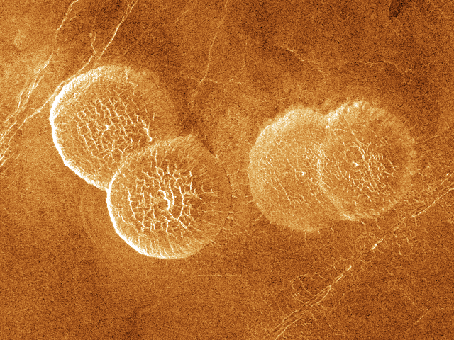

The Venus Transit 2004
... Brief InfoSheet D6
Venus' history and surface

Pancakes on Venus' surface (credit: NASA)
Most of our information about Venus' surface was obtained by the Soviet space probe missions Venera 15 and 16 and by the American Pioneer Venus and Magellan spacecraft during the period 1978 - 1994. Today we have good information about 98 percent of the surface.
Radar mapping reveals a varied terrain on the surface of Venus: mountains, plains, high plateaus, canyons, volcanoes, ridges, and impact craters. Overall, Venus looks fairly flat. Elevation differences vary little, only 2 to 3 km, except for a few highland regions.
The northern and southern parts of Venus differ remarkably. The northern part is mountainous, with uncratered upland plateaus; these resemble continents on Earth. The southern part has a relatively flat rolling terrain, which appears to consist of vast lava plains.
There are only two major highland areas. The largest continent, Aphrodite Terra, is close Venus' equator; its size is similar to South America. Another large continent at latitude 70°N is called Ishtar Terra. It measures some 1,000 km by 1,500 km. That is larger than the biggest highland plateau on Earth, the Himalayan plateau.
Over 1500 major volcanoes or volcanic features are known, and there may even be a million smaller ones. Most are shield volcanoes similar to Hawaii on Earth. More than 1000 volcanoes or volcanic centres are more than 20 kilometres wide.
There are also surface features that look just like rivers. Howver, they were not produced by water but by fluid lava flows. Some extend for hundreds of kilometres. One of these is nearly 7,000 km long, that is longer than the River Nile on Earth.
The second kind of crater which dots the surface of Venus is few in number but large in size, indicating a relatively young surface with a geological age less than 800 million years. These craters have been generated by meteor impact. There are no craters smaller than about 1.5 - 2 km. This is because smaller meteoroids are burnt up in the thick atmosphere - only the large ones get through to the surface and produce craters.
The Earth and Venus are almost equal in size so the interior of Venus is believed to have a metallic (iron) core about 3,000 km radius and a molten rocky mantle covering most of the planet. Unlike the Earth, Venus has a very small magnetic field apart from that induced by the effect of the solar wind.
Like the other terrestrial worlds of the solar system, Venus is presumed to have emerged about 4.6 billion years ago by accretion of tiny objects. The primordial crust formed and was heavily bombarded and cratered. During the bombardment phase there was enough heat produced to melt the whole protoplanet. After a certain cooling period, the molten mass developed a crust, a mantle and a core.
The low number of impact craters on Venus suggests that a large area of the crust was destroyed in its early history by lava flows.
The most mysterious aspect of Venus' history is the origin of its atmosphere. It would seem that the atmospheres of the Earth and Venus should be comparable because of their other similarities. However, the atmospheres obviously evolved in very different ways. This is most certainly connected in some way to the evolution of the oceans on our planet. Our understanding of the geological history of Venus will continue to be fragmentary until a comprehensive global investigation is undertaken.
Want to know more?
This topic is discussed in a more detailed way in the associated Extended InfoSheet.
Back to the List of Brief InfoSheets.
